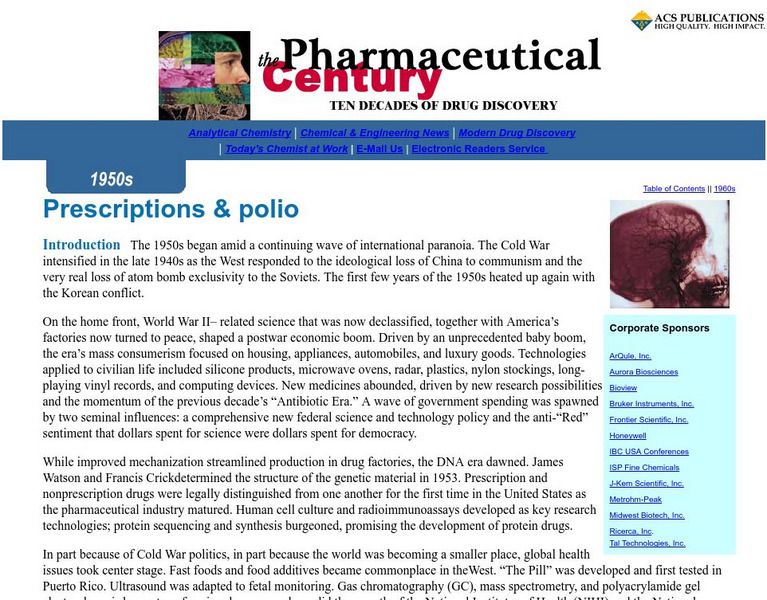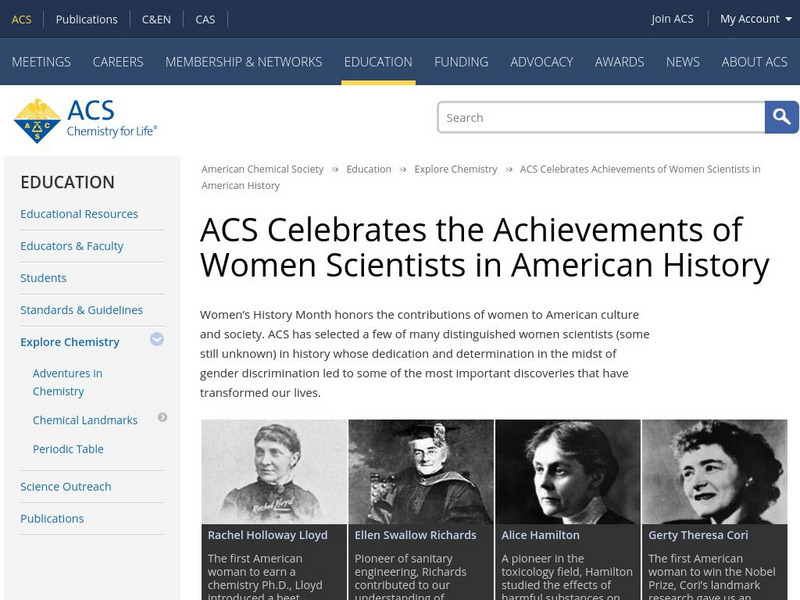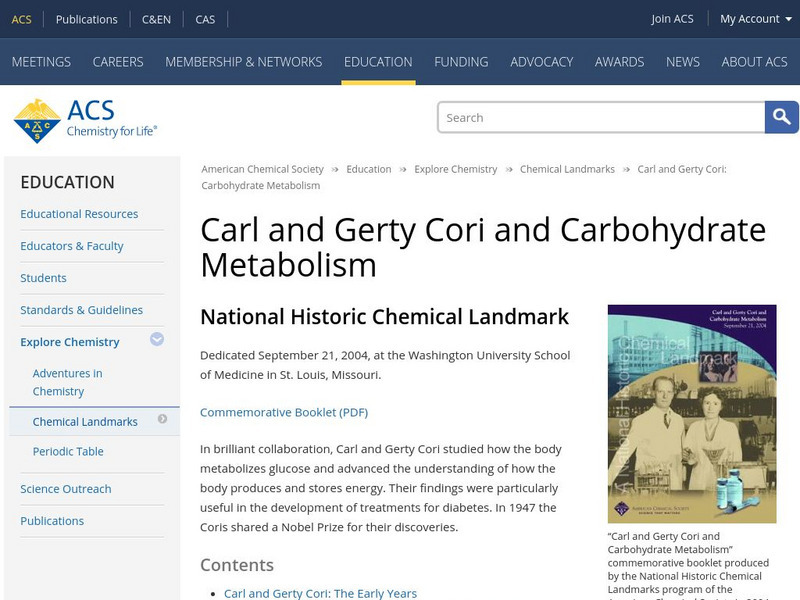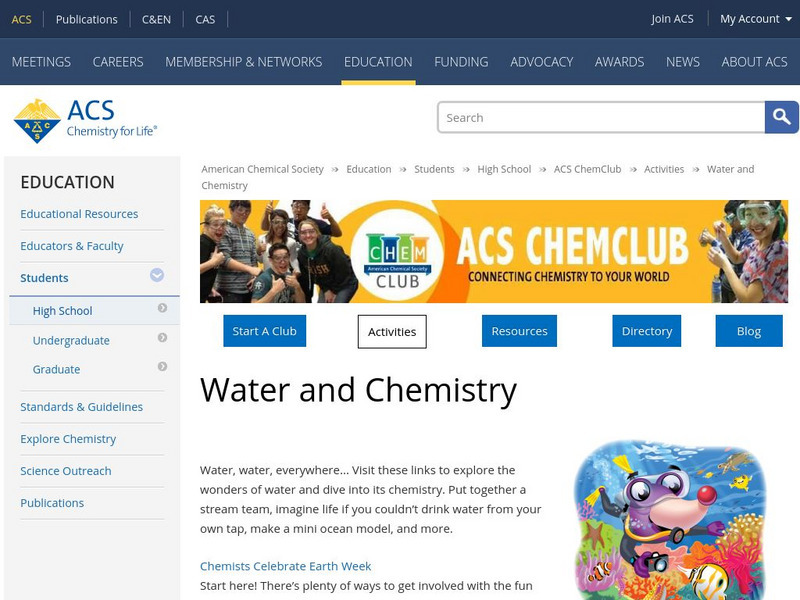American Chemical Society
Inquiry in Action: From Liquid to Gas to Solid
What causes frost to form on the outside of a cold container? In this activity, students will see that the liquid water can change state again and freeze to become ice.
American Chemical Society
Middle School Chemistry: Chapter 1: Solids, Liquids, and Gases
Five exemplary chemistry lessons about the three states of matter complete with handouts and animations.
American Chemical Society
Middle School Chemistry: Chapter 2: Changes of State
Five chemistry lessons about phase changes between the states of mattter complete with handouts and animations.
American Chemical Society
Middle School Chemistry: Chapter 3: Density
Six interactive chemistry lessons about density complete with handouts and animations.
American Chemical Society
Middle School Chemistry: Density: Sink and Float for Solids
Students determine whether an object will sink or float by comparing its density to the density of water.
American Chemical Society
Middle School Chemistry: Chapter 5: The Water Molecule and Dissolving
Nine exemplary chemistry lessons about the water molecule and dissolving complete with handouts and animations.
American Chemical Society
Middle School Chemistry: Chapter 6: Chemical Change
Twelve interactive chemistry lessons about chemical changes complete with handouts and animations.
American Chemical Society
Middle School Chemistry: P H and Color Change
Students see a demonstration of a color change using universal pH indicator and then change the concentrations of an acid and a base using a universal indicator to test the pH of the resulting solutions. Through an animation, they see...
American Chemical Society
Middle School Chemistry: Neutralizing Acids and Bases
Students will use citric acid and sodium carbonate solutions to see that adding a base to an acidic solution makes the solution less acidic. Students will then use a base to help them identify which of two acidic solutions is more...
American Chemical Society
Middle School Chemistry: Carbon Dioxide Can Make a Solution Acidic
Students explain that carbon dioxide from any source reacts chemically with water to form carbonic acid. They will also be able to use the color changes of universal indicator to monitor the changing pH of a solution during a chemical...
American Chemical Society
The Pharmaceutical Century: The 1950s
This extensive review of the advances in medical research and technology in the 1950s credits the Cold War and Cold War thinking with promoting scientific research and government funding of that research, including medical issues. Find...
American Chemical Society
Middle School Chemistry: Why Does Water Dissolve Sugar?
Explore this animation to learn why water dissolves sugar.
American Chemical Society
Middle School Chemistry: Temperature Changes in Dissolving
See how temperature changes affect dissolving and the molecular bonds in a water molecule.
American Chemical Society
Acs: Alice Hamilton and the Development of Occupational Medicine
Profile of Alice Hamilton (1869-1970), a pioneer in the field of occupational health. Includes a 4-page downloadable booklet of the material.
American Chemical Society
American Chemical Society: Science for Kids: Solids, Liquids and Gases
Engaging hands on science lessons for grades 2-6 on the three states of matter.
American Chemical Society
American Chemical Society: Hompage
ChemCenter, available from the American Chemical Society, provides chemistry news, reference sources and other public services.
American Chemical Society
American Chemical Society: Achievements of Women Scientists in American History
A collection of profiles of American women who have made significant contributions to science.
American Chemical Society
American Chemical Society: Carl and Gerty Cori and Carbohydrate Metabolism
Profiles of Carl and Gerty Corbi, American biochemists who studied how the human body metabolizes glucose. Their research advanced treatments for diabetes, and won them a Nobel Prize in 1947. Includes links to additional resources.
American Chemical Society
American Chemical Society: Development of Baking Powder
The invention of baking powder had a huge impact on bakers' ability to produce and distribute bread to large numbers of people. The history of this lowly ingredient is presented, along with a chemistry lesson plan for secondary students.
American Chemical Society
American Chemical Society: Directory of National Historic Chemical Landmarks
A database of milestones and accomplishments in the field of chemistry. The information is organized in four ways: by year, by category, by U.S. state, and by country.
American Chemical Society
American Chemical Society: Explore Chemistry: Water and Chemistry
Explore water's unique properties in the activities here. Includes ideas for starting a chemistry club, ideas for Earth Day, articles, and videos.
American Chemical Society
American Chemical Society: Holiday Chemistry
A collection of chemistry activities and experiments with a Christmas holiday theme.
American Chemical Society
American Chemical Society: Science for Kids: Chemical and Physical Change
Engaging hands-on science lessons for grades 2-6 on chemical and physical changes.
American Chemical Society
American Chemical Society: Science for Kids: Characteristics of Materials
Engaging hands-on science lessons for grades 2-6 on the properties of different materials.














